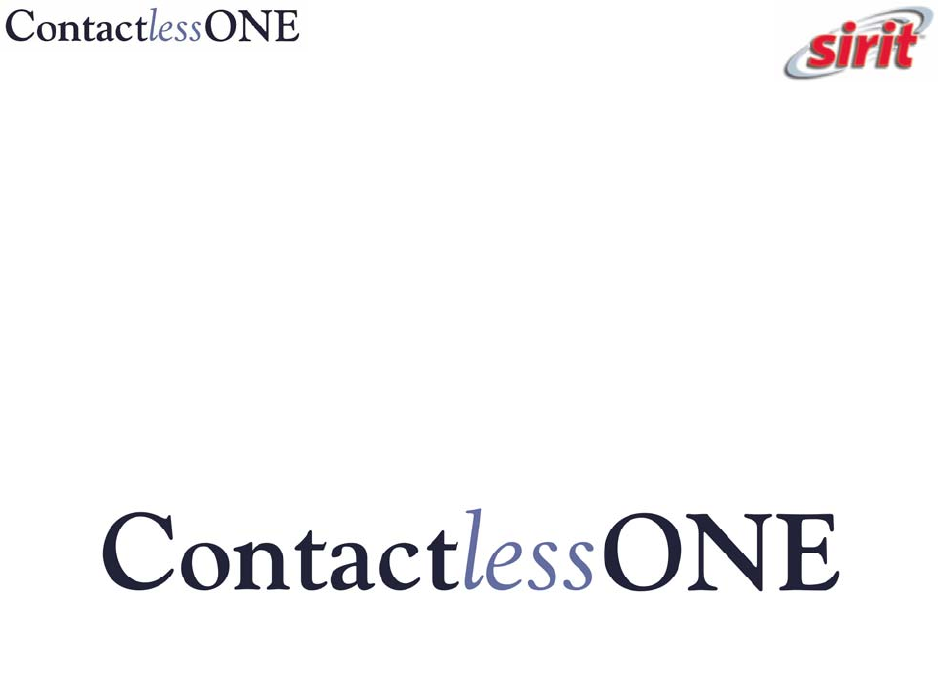3M Traffic Safety Systems PNPSDIO RFID Reader User Manual CERTIFICATE OF COMPLIANCE
3M Traffic Safety Systems RFID Reader CERTIFICATE OF COMPLIANCE
User Manual

Rhein Tech Laboratories, Inc. Client: Sirit Technologies Inc.
360 Herndon Parkway Model #: PnP SDIO
Suite 1400 Standards: FCC 15.225 & RSS-210
FCC/IC ID: M4ZPNPSDIO/3637B-PNPSDIO Herndon, VA 20170
http://www.rheintech.com Report #: 2006113
Page 27 of 37
Appendix I: Manual
Please refer to the following pages.

PnP SDIO User Guide
PnP SDIO User Guide
Preliminary Document v0.10
Copyright Sirit Inc. 2006

PnP SDIO User Guide
- 2 -
Table of Contents
1 – PNP SDIO MODULE OVERVIEW ........................................................................- 3 -
1.1 Description .........................................................................................................................................................- 3 -
1.2 PnP SDIO Start-Up Guide..................................................................................................................................- 4 -
1.3 Loading Software into PDA ...............................................................................................................................- 4 -
2- HARDWARE DESCRIPTION .................................................................................- 5 -
2.1 Hardware ............................................................................................................................................................- 5 -
3- SAFETY INSTRUCTIONS......................................................................................- 6 -
4- FCC COMPLIANCE................................................................................................- 6 -

PnP SDIO User Guide
- 3 -
1 – PnP SDIO Module Overview
1.1 Description
Model Name: PnP SDIO RFID Reader
Model Number: PnP SDIO
FCC ID: M4ZPNPSDIO
Industry Canada ID: 3637B-PNPSDIO
Description:
The Sirit PnP SDIO RFID Reader is a modular high-frequency radio frequency identification
(RFID) reader operating in the 13.560 MHz ISM band. It is designed as a secure digital
input/output (SDIO) plug-in card for use with personal digital assistants and potable computing
devices.
Antenna Specification:
Magnetic loop, 5-turn planer spiral, approximately square.
Partial Faraday shield on both sides of 4-layer PCB; 2.5-cm OD, 2.0-cm ID.
Modeled gain: -60dBi (EZNEC, Ver.4).

PnP SDIO User Guide
- 4 -
1.2 PnP SDIO Start-Up Guide
Operational Sequence:
First load software on the portable computing device as per section below. Then plug SDIO
module in to portable computing device.
Start application program in portable computing device.
Read RFID tags.
Other information or help with this document or the module, please visit the Sirit website at
www.pnprfid.com or email support at support@pnprfid.com.
=========Pocket PC Setup=========
1.3 Loading Software into PDA
Copy the projects in "MS\C1 PPC2003\examples\" folder to your hard drive. The rfid4ce project
can be manipulated however you like to use the SD RFID reader.
Microsoft is the company that releases PocketPC/WinCE. Their website is www.microsoft.com.
For support with the Embedded C++ development suite, please contact Microsoft or see their
website.
MS Visual Studio .NET
---------------------
First install Microsoft Visual Studio .NET development suite......unless you already have it
installed. You will need to purchase it from www.microsoft.com. Copy the projects in "MS\C1
PPC2003\examples\*_net_*" and "MS\C1 PPC2003\C1Lib_net" folders to your hard drive. The
*_net_* projects can be manipulated however you like to use the SD RFID reader. The
C1Lib_net is a .NET component that wraps the functions in the driver .DLLs and makes them
accessible to any .NET projects.
========= Using the Example Applications on Pocket PC =========
To use the reader in the PocketPC device
1. Plug the SDIO reader into the SDIO slot in the pda device
2. Use PocketPC ActiveSync to copy the ContactlessONE.cab file onto the device
3. Run the ContactlessONE.cab program, this will install the demo programs in "program
files\ContactlessONE\Examples" folder on the pda
4. Use the stylus to run the applications that are placed on the pda device. This program
will allow you to experiment with reading and writing to RFID tags and labels.

PnP SDIO User Guide
- 5 -
2- Hardware Description
2.1 Hardware
The PnP SDIO module uses the Inside Contactless (France) PicoRead chip set consisting of the
PicoRead RF processing chip and a custom programmed MicroChip Corporation (USA)
18F2550 micro controller unit (MCU). The SDIO interface uses a C-Guys (Japan) CG-100 chip
to translate from the serial data stream of the PicoRead MCU and the customer’s portable
computing device SDIO interface.
The host unit provides 3.3 volt power to the module, which is used to run the PicoRead chip set
and the CG-100 interface chip.
All three chips share a common 13.560 MHz crystal, using the MCU as the common oscillator
and drive source.

PnP SDIO User Guide
- 6 -
3- Safety Instructions
Power Disconnect Device
This device gets its power from the host computer. Unplug the device to take power away from
it. Do not use the device if it becomes wet. Do not use the device while it is immersed in water.
WARNING:
FCC Radiation Exposure Statement: This device emits low levels of RF energy when in
operation. Do not allow the use of this device by someone using a cardiac pacemaker or other
medical devices sensitive to RF energy.
4- FCC Compliance
Changes or modifications not expressly approved by Sirit Corporation will void the user’s
authority to operate the equipment.
FCC Compliance
This device complies with Part 15 of the U.S. Federal Communications Commission (FCC)
Rules. Operation is subject to the following Conditions:
1. This device may not cause harmful interference.
2. This device must accept any interference that may cause undesired operation.
This equipment has been tested and found to comply with the limits for a Class B digital device,
pursuant to Part 15 of the FCC rules. These limits are designed to provide reasonable protection
against harmful interference in a residential installation. This equipment generates, uses and can
radiate radio frequency energy and, if not installed and used in accordance with the instructions,
may cause harmful interference to radio communications. However, there is no guarantee that
interference will not occur in a particular installation. If this equipment does cause harmful
interference to radio or television reception, which can be determined by turning the equipment
off and on, the user is encouraged to try to correct the interference by one or more of the
following means:
1. Rotate or relocate the receiving antenna;
2. Increase the separation between the equipment and receiver;
3. Connect the equipment into an outlet on a circuit different from that to which the receiver is
connected;
4. Consult the manufacturer customer service department for help.